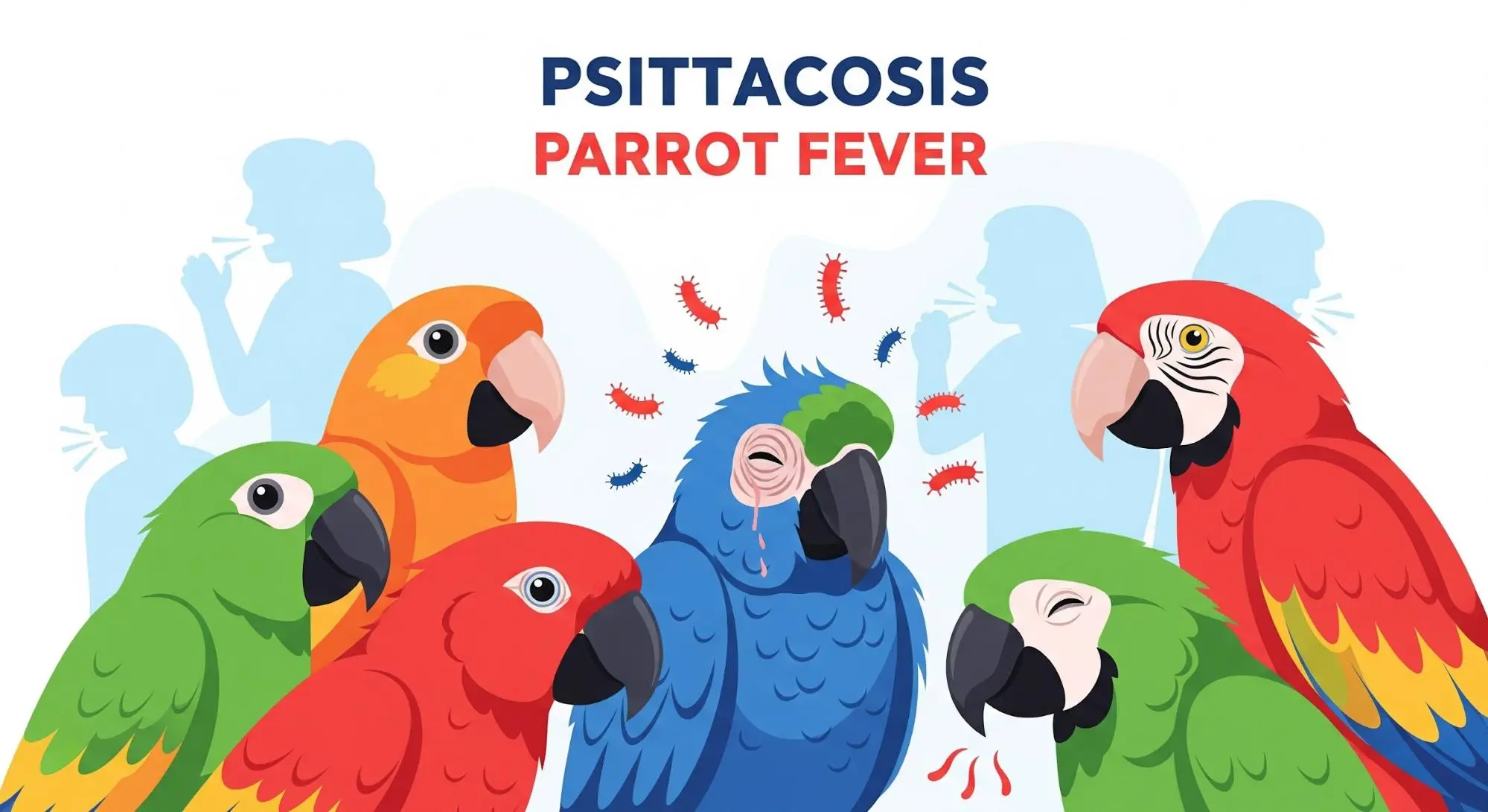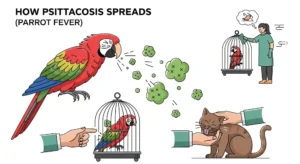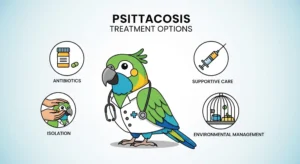Psittacosis (Parrot Fever): Symptoms, Diagnosis, and Treatment

This is why education and awareness are necessary. The early identification of parrot fever signs, correct diagnosis, and timely treatment of Psittacosis in parrots can be the difference between life and death.
Let’s look at what every bird lover and vet should know.
What Is Psittacosis?
Did you know that Psittacosis in parrots, called “Parrot Fever,” is a bacterial infection caused by Chlamydia psittaci?
The disease infects a range of birds, including parrots, pigeons, and ducks. The worst news is that the disease can also be passed on to human beings.
A knowledge of this disease guarantees safe interactions between birds and owners. For your parrots and your safety, it is good to know what causes this disease.
Causes of Psittacosis
The primary cause of Psittacosis in parrots is the bacterium Chlamydia psittaci. Bacteria can be transmitted by birds even when they are asymptomatic. Birds may shed bacteria through their droppings, feathers, and respiratory secretions.
Poor sanitation, crowding, and environmental stress have the potential to increase the risk of infection. When owners recognize these causes, they reduce exposure and offer early veterinary help.
Once you have learned about the causes, you then need to know about the means through which the disease is spread.
How Psittacosis Spreads

Parrot psittacosis is infectious when sick birds shed bacteria into their environment. Humans and birds can also be infected when they inhale dust that has droppings or feathers. Poor cage cleaning and handling birds without protective equipment raise the risk.
Exposure can happen so suddenly. This is the reason why recognizing the early symptoms of Parrot Fever is crucial. Timely detection can significantly impact treatment outcomes.
It brings us to an important question. How can you identify the symptoms of Parrot Fever? Moving forward, we shall discuss that.
Identifying the Symptoms
Early identification of Parrot Fever symptoms enhances the prognosis of birds and humans alike. In parrots, observe:
- Lethargy and lack of activity
- Poor appetite and loss of weight
- Ruffled feathers
- Sneezing
- Watery droppings or diarrhea
Infected birds can transmit this bird disease to humans. The symptoms may include fever, muscle pain, dry coughing, and pneumonia in advanced cases.
Spotting symptoms is just the first step. A correct Psittacosis diagnosis is essential for proper care.
Diagnosis of Psittacosis
Correct diagnosis of Psittacosis ensures proper treatment and prevents transmission. Symptoms often resemble those of other diseases in birds. Therefore, laboratory tests are essential.
- Veterinarians investigate birds for clinical signs such as lethargy, nasal discharge, or respiratory distress.
- Laboratories perform blood and fecal tests to identify Chlamydia psittaci.
- PCR testing identifies bacterial DNA in birds with the greatest sensitivity.
- Physicians prescribe chest X-rays, blood work, or PCR when humans are exposed to infected birds.
Early detection accelerates recovery and avoids the spread of Parrot Fever disease to other birds and people. Once vets and doctors confirm the infection with a proper diagnosis, the next important step is practical treatment.
Psittacosis Treatment Options
 Treatment for psittacosis includes antibiotics such as doxycycline for parrots and humans. Supportive therapy through hydration and keeping birds warm aids in the quicker recovery of the birds. Finishing the entire course of medication avoids relapse and full recovery.
Treatment for psittacosis includes antibiotics such as doxycycline for parrots and humans. Supportive therapy through hydration and keeping birds warm aids in the quicker recovery of the birds. Finishing the entire course of medication avoids relapse and full recovery.
In human beings, early administration of the antibiotic is essential. Other medications, like azithromycin, can be administered in case of an allergy to doxycycline. Early treatment minimizes complications from this dangerous Parrot Fever disease.
Preventive measures, along with treatment, reduce the chance of future infections.
Preventing Psittacosis
Prevention is paramount in controlling Psittacosis in parrots. Quarantine new birds for a minimum of 30 days. Routine cage and aviary cleaning, gloved and masked contact with birds, and limiting dust exposure all reduce the risk.
Supporting your birds’ overall health through proper nutrition and daily care also improves their immunity, making them less vulnerable to disease. Still curious? Learn more at Parrot Cuisine.
Moreover, regular veterinary check-ups detect infections early. Pet owners and vets who are aware of risks can prevent complications. These actions help keep you and your bird companions safe and healthy.
Risk Factors
Certain birds are more vulnerable to Psittacosis in parrots. This includes young birds, those under stress, and birds in crowded aviaries. Humans at higher risk are bird owners, veterinarians, and pet store employees.
Knowing these factors helps in taking steps to lower the chance of infection. If birds or humans become infected, proper recovery is important for complete health.
Recovery Tips
Recovery from Psittacosis relies on quick action and proper care. Both birds and humans need supportive treatment to heal fully and prevent further spread. Simple but consistent steps can make recovery smoother.
- Detect early and start treatment: A quick response improves recovery chances.
- Care for sick birds: Provide a quiet, warm space, clean water, and a nutritious diet.
- Isolate infected birds: This prevents the bacteria from spreading to others.
- Human care matters too: Rest well, stay hydrated, and complete the antibiotic course.
- Stay consistent: Proper follow-up ensures full recovery from Parrot Fever disease.
Staying informed helps owners and veterinarians keep birds healthy over the long term.
Psittacosis in parrots doesn’t have to be a mystery at all. By watching for symptoms of Parrot Fever, getting the proper diagnosis for Psittacosis, and moving quickly, parrot owners can keep their birds safe from infection. This way, they can protect themselves as well.
Prevention through cleaning, quarantine, and management is still the best form of defense.
If you’re a veterinarian who wants to stay informed about avian health, explore ongoing learning opportunities with veterinary CE to improve your skills. Knowledge is the best medicine, so keep learning.
Stay proactive, and provide your parrots with the healthy future they deserve.
Frequently Asked Questions
Yes. Psittacosis can spread from birds to humans through inhaling dried droppings, feathers, or secretions from infected birds. Human-to-human transmission is extremely rare.
Early symptoms include loss of appetite, ruffled feathers, sneezing, watery droppings, and lethargy. Some birds may not show visible signs until the infection worsens.
Veterinarians test bird swabs or blood samples to detect Chlamydia psittaci bacteria. PCR testing offers the highest accuracy for diagnosis.
Antibiotics like doxycycline are commonly prescribed for both birds and humans. Full treatment must be completed to prevent relapse.
Treatment usually lasts 2–4 weeks depending on severity. Symptoms may ease early, but full recovery requires completing the full antibiotic course.
Prevention steps include quarantining new birds for 30 days, cleaning cages often, wearing protective gear, and buying only from trusted sources.
Psittacine birds like parrots, parakeets, cockatiels, and lovebirds are most affected, though other birds such as pigeons and ducks can also carry the disease.
Human-to-human transmission is extremely uncommon. Almost all cases come from infected birds rather than other people.
Wear gloves and masks when cleaning cages, moisten droppings to reduce dust, and schedule regular veterinary checkups for your birds.
In birds, the infection can become fatal. In humans, it can lead to severe pneumonia and organ issues if not treated promptly.
